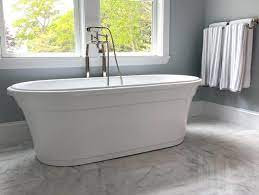When it comes to choosing a free standing bathtub, you have a lot of options. You can choose a wide or extra-wide tub or a double slipper tub to maximize your soaking experience. Here are a few tips to help you choose a tub that’s right for you: Dimensions, Material, and Styles.
Dimensions of a freestanding bathtub
Freestanding bathtubs are becoming increasingly popular. They are often associated with opulence and luxury, but they are actually quite affordable. They come in a variety of sizes and can be used by one person, a couple, or even for children. They are usually between 15 and 22 inches tall. Choosing the right size is crucial to ensuring that your tub will fit into your space. Read on to learn more about freestanding bathtubs and the many benefits they offer.
Freestanding bathtubs are one of the easiest to recognize. Because they do not attach to the walls, they are usually placed in the center of the bathroom. This creates a beautiful focal point and can be a great feature of the bathroom. Freestanding bathtubs come in a variety of shapes, but the most common are clawfoot tubs and oval tubs.
Freestanding bathtubs are generally shorter than other tubs. Some are even less than forty inches wide. They are also much more difficult to install, which makes them ideal for small bathrooms.
Materials
The materials used to make bathtubs have a major impact on their functionality, durability, and style. The most common materials used in bathtub construction are acrylic, fiberglass, and cast iron. Acrylic tubs are lightweight and scratch resistant, while fiberglass tubs are durable and easy to clean. Fiberglass tubs are made of fiberglass reinforced resin. Stone resin bathtubs are made from a combination of resin and natural minerals.
To determine which materials are best for your bathroom, consult with a professional. It is important to make sure that the freestanding tub satisfies any structural code in your building. If you live in an older home, you might need to consult with a structural engineer, especially if you intend to install a heavy-duty bathtub. In addition, you will need to level the floor of your bathroom, so that it is level throughout the bathtub.
Acrylic tubs are lightweight and easy to install. They are also relatively cheap and easy to maintain. Acrylic is a very versatile plastic that can be molded into various shapes without losing its structural integrity. Also, it resists stains and bacteria. However, it is not as durable as cast iron or copper.
Styles
Freestanding tubs can be placed against a wall, saving space in a small bathroom. They also make it easy to install cabinets flush against the ends. In addition, the center of the tub is a good place to put a faucet or overflow drain. There are two main styles of freestanding tubs: single ended and double slipper.
There are many different styles of freestanding tubs, including modern and traditional designs. Traditional tubs have been around since the 1800s, and they can be single or double ended. They come with slippers or without them. They also come with faucets, and you can choose single or double-handle faucets.
Freestanding bathtubs come in several different styles, including traditional clawfoot tubs and sleek modern designs. They are a great choice for bathrooms with odd-shaped rooms, as they do not need to be attached to walls. However, they require more space, so they may not be the best choice for smaller spaces.




